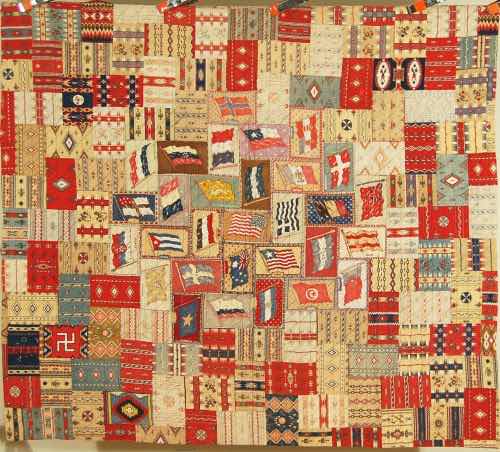Other early patchwork quilts were charm quilts and log cabin quilts. The log cabin pattern originated in England and was brought to America by early colonists.

String quilts, in which strips of various fabrics were sewn together, then cut into blocks and made into a quilt, were a popular choice because they allowed quilts to be constructed of scraps that normally would be too narrow to be worth using. A prime example of this is the Victorian cigar ribbon quilt. Today's strip piecing method and bargello are modern adaptations of string quilts.
Slave women learned quilt patterns from their mistresses as well as from each other. They also developed ingenious original patterns based on elements from their environment. Early African American quilters were quite resourceful in finding and using discarded goods to use in their quilts. In addition to scraps from cloth used to make their clothes, slave quilters made good use of feed, flour and sugar sacks. The inner layer of the quilts would be filled with old blankets, worn clothes that could no longer be mended, or bits and pieces of wool or raw cotton. Gee's Bend, Alabama is famous for its African American style quilts.





This method would be used again during the Depression. This must have been a very humbling experience for those who were old enough to have remembered slavery or owned slaves. They would have known they were wearing slave clothing and making slave quilts. My great aunt made this one out of old shirts.
Just after the turn of the century, cigarette companies began to press their sales. They had already been inserting trading cards of sports figures into their packages to attract teenage boys and men. Around the first decade of the century, they began to include a small silk picture. By shifting to offering pictures on silks, companies could use the buying power of women. Women were eager to obtain these popular sets of printed silk. By 1920, cigarette smoking had become quite common among women.
Another form of popular novelties packaged with tobacco was allied flag printed flannels. An innovative motif included both oriental and Navajo designs touted as miniature Indian rugs. The practice of giving away novelties to promote the sale of tobacco products diminished with the outbreak of World War II. Note the swatztika on the third row from the bottom in the above quilt.
The Crown Royal whiskey distillery followed suit by packaging their bottles in flannel bags. Crown Royal quilts made with the bags are still very sought after.
2-1/2" Quilt Stick
Dritz Omnigrid Square Template Set $17.99
Marti Michell Drunkard's Path Template Set $13.99
2-1/2" Quilt Stick
Dritz Omnigrid Square Template Set $17.99
Marti Michell Drunkard's Path Template Set $13.99
Any other template may also be used.





No comments:
Post a Comment